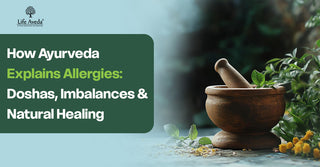Abstract
There are a lot of things in nature and about the human body which we are trying to understand or we don’t understand. But if we look through the window of Ayurveda then a lot of things make sense and have the perfect explanation of everything.
For Example about the working of the human body, there are a lot of things that modern science has termed idiopathic especially when it comes to the diagnosis of a disease but Ayurveda suggests that a good doctor should never confuse himself in naming different diseases. Instead must understand the imbalance of doshas and should proceed with the treatment accordingly.
But before understanding the Dosha imbalance, it is important to know the details about each dosha. In this blog, we will go through the details of Pitta Dosha along with Pitta Prakriti Purusha's characteristic features.
Introduction
Pitta dosha is a combination of two universal elements that are fire and water. It is also called the thermal energy of the body and has a major role in metabolism. The hormonal secretions in your body, functioning of liver, production of digestive enzymes, maintained temperature of your body and many other functions are due to the balanced pitta dosha or thermal energy. Any imbalance in thermal energy can result in metabolic disturbance, hormonal imbalance, disturbance in the functioning of the liver and digestive system.
Read the blog till the end to know all the details about Pitta dosha.
Everything About Pitta Dosha
As mentioned before Pitta dosha is the master of metabolic function going on inside the body. Pitta dosha also has five types and each type has its location and importance in the human body. Moving forward let’s discuss the properties of pitta dosha and its five types and factors responsible for aggravation and pacification of pitta Dosha.
Properties of Pitta Dosha
पित्तम सस्नेह तीक्षणोषणं लघु विस्रं सरं द्रवम। (Ashtanga hridayam)
|
Parameters |
Properties |
|
|
Laghu (Lightness) |
|
|
Tikshna (piercing) |
|
|
Ushna (Hot) |
|
|
Saram (fluidity) Dravam (Liquidity) Visram (Dense) |
|
|
Tikshna (Of Piercing nature) |
Types of Pitta Dosha
The Five types of Pitta dosha are as follows:
Pachak Pitta
Ranjaka Pitta
Bhrajaka Pitta
Alochaka Pitta
Sadhaka Pitta
Locations & Functions of 5 types of Pitta
The general location of Pitta dosha is the middle part of the body, which is marked between the heart and umbilicus. Specific types, location and functions are as follows:

|
S.No |
Types Of Pitta |
Location |
Function |
|
|
Pachak Pitta |
Pakva amashaya madhya (In between the stomach and large intestine) |
Chaturvidha annapanam pachti (digestion of four types of foodstuff) Vivechyati cha dosha rasa mutts purishani (Differentiation of nutrients & waste products from food) Sheshanam pitta santhanam anugraham karoti (provides support & energy to another pitta) |
|
|
Ranjaka Pitta |
Yakrit (Liver) Pliha (Spleen) Amashaya (Lower part of stomach & duodenum) |
Rasasya ragkrit (Impact color to blood) |
|
|
Bhrajaka Pitta |
Twacha (Skin) |
Absorption of various abhyanga (massages), Parisheka (Showering), Avagahana (Tub bath), avlepana (Local Application) Chayanam cha prakashaka (radiates skin glow) Kantikaritvam (Gives luster to skin) Maintains body temperature |
|
|
Alochaka Pitta |
Eyes (Drishti) |
Rupa grahana (Perception of vision) |
|
|
Sadhaka Pitta |
Indriya (Heart) Mastishka (Brain) |
Abhi Partita manoratha (Carrying out desires Buddhi (Power to make decisions) Medha (Intellect) Abhimana (Self esteem) Utsaha (Enthusiasm) Shabda (Perception of word) Sparsha (Touch) Gandha (Odor) |
Factors Responsible for Pitta Imbalance in the Body
The Factors of Pitta aggravation and pacification are as follows:
Factors responsible for Aggravation of Pitta Dosha
The factors responsible for the aggravation of pitta dosha are of two types: natural and acquired. The natural factors include:
Season (Accumulation in Varsha ritu (Rainy Season))
Aggravates during meal digestion
Gets vitiated in the middle of the day (Madhyanha) & at night (Ardharatri)
In middle-aged people, pitta is excess compared to children and old people.
The acquired factors include intake of food articles with dominance of pungent, sour, salty taste & hot potency. Upavasa (Fasting), Ayasa (Overstrain) Maithuna upagamana (excessive sexual indulgence) also aggravate pitta dosha. In addition, Krodha, Shoka and bhaya (Anger, sorrow & fear) also cause pitta vitiation.
Factors responsible for the Pacification of Pitta
One should avoid intake of substances like chilies, alcohol, sour and spicy things which can aggravate the pitta dosha in varsha ritu (Rainy season) & excessive intake of food that vitiates pitta dosha should also be avoided. Upavasa (Fasting), Ayasa (Overstrain) & Maithuna upagamana (excessive sexual indulgence) are to be limited.
Signs of Pitta Balance/ Imbalance in the body
Pitta Balance in the body
The balance pitta helps in the smooth functioning of the body's metabolism. It provides balanced body heat and digestion along with proper liver functioning. The skin is radiating, bowel habits are good and there is no interruption in sleep as well. The personality of a person with a balanced pitta is almost a perfectionist
Pitta Imbalance in the body
In case of Pitta imbalance in the body, the digestion will not be normal thus toxic by-products will form ama (endotoxins). This also results in improper perception of visual objects by eyes (visual errors), abnormality in body temperature, impairment in skin complexion along with fear, delusion worry.
Pitta Prakriti Purusha
Pitta Prakriti Purusha has the following characteristics:
- The person with the dominance of pitta dosha in the body gets premature greying of hairs, is short-tempered and sweats profusely.
- In dreams, they see flashes or fire, are intolerant to sun or hot temperatures and have fair complexioned body parts.
- Such a person will have excessive hunger and thirst, may have early wrinkles along with soft scanty and brownish mustaches.
- The tongues, lips & palms are reddish.
- The mind of such people is really sharp with high intelligence and they always try to control the argument with their own words.
Conclusion
Pitta Dosha as mentioned above is responsible for all the metabolic functions going on inside the body. All three doshas are important for our body and its working, especially their balance. Though modern science does not have answers to many questions, if understood from Ayurveda's viewpoint, everything has an answer and we just need to believe the knowledge Ayurveda shares with the world. A system of medicine with explanations for everything but still needs to be understood completely. For more Knowledge about doshas and prakriti.



